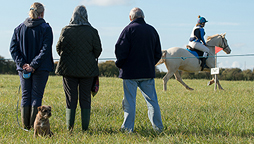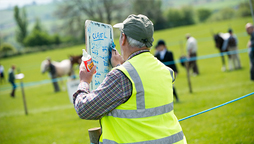Equestrian sport is full of technical terms and jargon, which may be confusing when you're first starting out. Here are just a few of the terms you might come across and what they mean...
For the horse
- Horse – a fully grown adult equine that's over 14.2 hands high (note that horse is often used to refer to both horses and ponies can be used interchangeably e.g. horse riding can include riding ponies, too)
- Pony – fully grown adult equine that's 14.2 hands high and under
- Foal – a young horse or pony that's under 1 year old
- Hands/ hands high (hh) – the unit that horses and ponies are measured in, with one hand equalling four inches. The measurement is from the ground to the withers, which is the top of the horse's shoulder just in front of the saddle
- Mane – the hair running down the length of the horse's neck
- Forelock – the hair that grows over the forehead of the horse, between the ears. It's the horse equivalent to a human fringe
- Hoof – the name for a horse’s foot
Horse paces
- Walk = a gentle four-beat gait that's approximately 4 mph
- Trot = a two-beat gait that's approximately 8 mph
- Canter = a three-beat gait that's approximately 10–17 mph
- Gallop = a fast, ground-covering, four-beat gait that's approximately 20 – 30 mph
Equipment for the horse
| Name |
Description |
| Tack |
The equipment used on horses. Putting tack onto a horse is called ‘tacking up’ |
| Head collar |
Headgear that is used to lead or tie up a horse. It fits behind the ears and around the muzzle |
| Lead rope |
The rope attached to the head collar for leading a horse or and tying the horse up |
| Bridle |
The piece of tack placed on the horse's head when riding, which allows the rider to control the horse |
| Bit |
The piece of tack attached to the bridle that sits in in the horse's mouth. They're normally metal, but can also be made from other materials such as plastic or rubber |
| Reins |
The straps that the rider holds in their hands, which attach to the bit and loop over the horse's neck |
| Saddle |
The piece of tack placed on the horse's back where the rider sits |
| Stirrups |
The metal accessories that the rider places their feet in. The're attached to the saddle by long, adjustable straps called stirrup leathers |
| Saddle pad/ numnah |
A soft pad or cloth that sits under the saddle to provide cushioning for the horse and helps to keep the saddle in place |
| Girth |
The thick strap that secures the saddle to the horse, running just behind behind the front legs |
For the rider
| Name |
Description |
| Jodhpurs, breeches, riding tights |
Trousers worn by riders that are normally close-fitting for safety and comfort. They have no seams along any areas in contact with the saddle, and will often have suede or grippy patches on the inside of the knees or on the seat to help the rider stay secure |
| Jodhpur boots |
Specialist riding footwear that are ankle-high with a smooth sole and small heel |
| Chaps |
Normally worn with jodhpur boots, they wrap around the rider's lower legs to protect them from rubbing against the saddle and to provide extra grip |
| Riding boots |
Specialist knee-high boots for riding that have a smooth sole and small heel |
| Riding gloves |
Gloves designed specifically for riding, with extra grip and no seams in the areas that the rider holds the reins |
| Body protector |
A protective item made from layers or blocks of foam, worn on the top half of the rider for safety |
| Riding hat/helmet |
These hats are designed specifically for horse riding. They have a hard outer shell over protective cushioning and three point strap that fastens under the rider's chin. Some riding hats will have a peak at the front, while others – known as skull caps or jockey skulls – don't. However, some skull caps are fitted with a decorative covering or 'silk', which may include a soft, flexible peak. Hat should always conform the current safety standards. |
On the yard
| Name |
Description |
| Yard |
The area where horses are kept |
| Riding centre/riding school/equestrian centre/ riding facility |
These are all terms used to describe a business that provides riding services, including use of horses and ponies |
| Livery/ Livery yard |
This is a facility that provides a service where people pay to keep their own horses at the yard. Some yards have a livery alongside a business providing lessons (see riding centre/school), while other yards are purely set up for customers to pay to keep their horses there |
| Field or paddock |
The outdoor space where horses live and graze |
| Stable |
The indoor space where horses live |
| Kick bolt |
The lock used at the bottom of a stable door |
| Hay |
Dried grass that horses eat |
| Haylage |
Semi-dried grass that is wrapped in plastic and left to naturally ferment. It's more nutritious than hay and contains less dust |
| Horse feed |
Highly nutritional food for horses, fed much more sparingly than grass, hay or haylage |
| Tack room |
A secure room where horse tack and equipment are kept |
| Arena/school/manege |
The space where you exercise horses, usually with a sand and/or fibre surface. It could either be outdoors with no cover, or indoors with a large roof cover |
| Hack/hacking |
A form of exercise on horses outside of the arena, usually on fields, bridleways (public rights of way where horses are allowed) or quiet roads |
| Schooling |
The name for exercise usually undertaken inside an arena to train the horse and rider |
| Mount |
The action of getting on a horse |
| Dismount |
The action of getting off a horse |
| Farrier |
The specially trained and qualified person who looks after the horses’ feet (hooves) and fits horseshoes |

